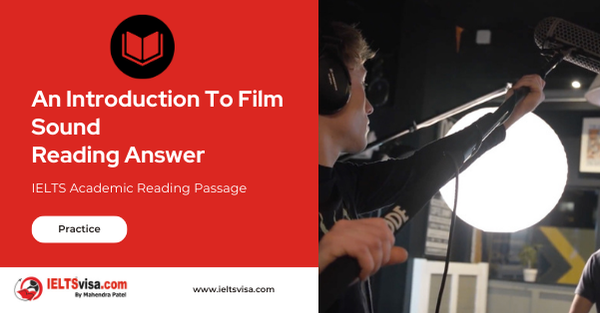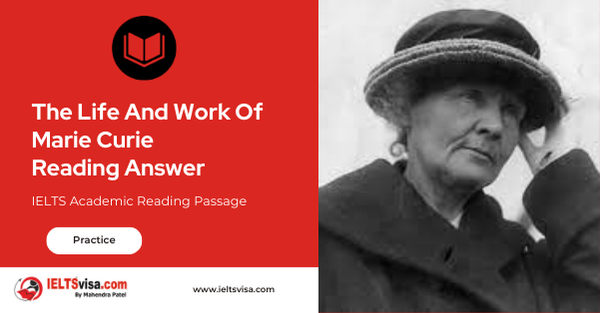An Introduction To Film Sound Reading Answer
IELTS Academic Reading Passage
Though we might think of film as an essentially visual experience, we really cannot afford to underestimate the importance of film sound. A meaningful sound track is often as complicated as the image on the screen, and is ultimately just as much the responsibility of the director. The entire sound track consists of three essential ingredients: the human voice, sound effects and music. These three tracks must be mixed and balanced so as to produce the necessary emphases which in turn create desired effects.
Topics which essentially refer to the three previously mentioned tracks are discussed below. They include dialogue, synchronous and asynchronous sound effects, and music.
Let us start with dialogue. As is the case with stage drama, dialogue serves to tell the story and expresses feelings and motivations of characters as well. Often with film characterization the audience perceives little or no difference between the character and the actor. Thus, for example, the actor Humphrey Bogart is the character Sam Spade; film personality and life personality seem to merge. Perhaps this is because the very texture of a performer’s voice supplies an element of character.
When voice textures fit the performer’s physiognomy and gestures, a whole and very realistic persona emerges. The viewer sees not an actor working at his craft, but another human being struggling with life. It is interesting to note that how dialogue is used and the very amount of dialogue used varies widely among films. For example, in the highly successful science-fiction film 2001, little dialogue was evident, and most of it was banal and of little intrinsic interest. In this way the film-maker was able to portray what Thomas Sobochack and Vivian Sobochack call, in An Introduction to Film, the ‘inadequacy of human responses when compared with the magnificent technology created by man and the visual beauties of the universe’.
The comedy Bringing Up Baby, on the other hand, presents practically non-stop dialogue delivered at breakneck speed. This use of dialogue underscores not only the dizzy quality of the character played by Katherine Hepburn, but also the absurdity of the film itself and thus its humor. The audience is bounced from gag to gag and conversation to conversation; there is no time for audience reflection. The audience is caught up in a whirlwind of activity in simply managing to follow the plot. This film presents pure escapism – largely due to its frenetic dialogue.
Synchronous sound effects are those sounds which are synchronized or matched with what is viewed. For example, if the film portrays a character playing the piano, the sounds of the piano are projected. Synchronous sounds contribute to the realism of film and also help to create a particular atmosphere.
For example, the ‘click’ of a door being opened may simply serve to convince the audience that the image portrayed is real, and the audience may only subconsciously note the expected sound.
However, if the ‘click’ of an opening door is part of an ominous action such as a burglary, the sound mixer may call attention to the ‘click’ with an increase in volume; this helps to engage the audience in a moment of suspense.
Asynchronous sound effects, on the other hand, are not matched with a visible source of the sound on screen. Such sounds are included so as to provide an appropriate emotional nuance, and they may also add to the realism of the film. For example, a film-maker might opt to include the background sound of an ambulance’s siren while the foreground sound and image portrays an arguing couple. The asynchronous ambulance siren underscores the psychic injury incurred in the argument; at the same time the noise of the siren adds to the realism of the film by acknowledging the film’s city setting.
We are probably all familiar with background music in films, which has become so ubiquitous as to be noticeable in its absence. We are aware that it is used to add emotion and rhythm. Usually not meant to be noticeable, it often provides a tone or an emotional attitude toward the story and /or the characters depicted. In addition, background music often foreshadows a change in mood. For example, dissonant music may be used in film to indicate an approaching (but not yet visible) menace or disaster.
Background music may aid viewer understanding by linking scenes. For example, a particular musical theme associated with an individual character or situation may be repeated at various points in a film in order to remind the audience of salient motifs or ideas.
an acceleration of music during car chases and creaky doors in horror films. Yet, it is important to note as well that sound is often brilliantly conceived. The effects of sound are often largely subtle and often are noted by only our subconscious minds. We need to foster an awareness of film sound as well as film space so as to truly appreciate an art form that sprang to life during the twentieth century – the modern film.
Questions 1-5
Choose the correct letter, A, B, C or D
Write the correct letter in boxes 1-5 on your answer sheet.
1. In the first paragraph, the writer makes a point that
A. The director should plan the sound track at an early stage in filming.
B. It would be wrong to overlook the contribution of sound to the artistry of films.
C. The music industry can have a beneficial influence on sound in film.
D. It is important for those working on the sound in a film to have sole responsibility for it.
2. One reason that the writer refers to Humphrey Bogart is to exemplify
A. The importance of the actor and the character appearing to have similar personalities.
B. The audience’s wish that actors are visually appropriate for their roles.
C. The value of the actor having had similar feelings to the character.
D. The audience’s preference for dialogue to be as authentic as possible.
3. In the third paragraph, the writer suggests that
A. Audiences are likely to be critical of film dialogue that does not reflect their own experience.
B. Film dialogue that appears to be dull may have a specific purpose.
C. Filmmakers vary considerably in the skill with which they handle dialogue.
D. The most successful films are those with dialogue of a high Quality.
4. What does the writer suggest about Bringing Up
A. The plot suffers from the filmmaker’s wish to focus on humorous dialogue.
B. The dialogue helps to make it one of the best comedy films ever produced.
C. There is a mismatch between the speed of the dialogue and the speed of actions.
D. The nature of the dialogue emphasises key elements of the film.
5. The writer refers to the ‘click’ of a door to make the point that realistic sounds
A. Are often used to give the audience a false impression of events in the film.
B. May be interpreted in different ways by different members of the audience.
C. May be modified in order to manipulate the audience’s response to the film.
D. Tend to be more significant in films presenting realistic situations.
Questions 6-10
Do the following statements agree with the information given in Reading Passage? In boxes 6-10 on your answer sheet, write
TRUE if the statement agrees with the information
FALSE if the statement contradicts the information
NOT GIVEN if there is no information on this
6. Audiences are likely to be surprised if a film lacks background
7. Background music may anticipate a development in a
8. Background music has more effect on some people than on
9. Background music may help the audience to make certain connections within the film.
10. Audiences tend to be aware of how the background music is affecting them.
Questions 11-13
Complete each sentence with the correct letter below.
Write the correct letter, A-E, in boxes 11-13 on your answer sheet.
A. When the audience listens to the dialogue.
B. If the film reflects the audience’s own concerns.
C. If voice, sound and music are combined appropriately.
D. When the director is aware of how the audience will respond.
E. When the actor s appearance, voice and moves are consistent with each other.
11. The audience’s response to different parts of a film can be controlled 11…………………
12. The feelings and motivations of characters become clear 12…………………
13. A character seems to be a real person rather than an actor 13…………………

Solution:An Introduction To Film Sound Reading Answer
| 1. B | 8. NOT GIVEN |
| 2. A | 9. TRUE |
| 3. B | 10. FALSE |
| 4. D | 11. C |
| 5. C | 12. A |
| 6. TRUE | 13. E |
| 7. TRUE |
Review and Practice
- Regularly practice with IELTS reading samples and time yourself to get used to the pressure of the exam.
- Review your mistakes to understand where you went wrong and how to avoid similar errors in the future.
Our Books
Master IELTS Speaking Part 1
IELTS Writing Task 1 Book
IELTS Writing Task 2 Book
An Introduction to Film Sound Reading Answer Explanation
| Question No | Question Type | Answer | Keywords | Supporting Sentence | Location of Keywords | Explanation |
|---|---|---|---|---|---|---|
| 1 | Solution with Explanation | B | ‘cannot afford to underestimate the importance of film sound’ | Though we might think of film as an essentially visual experience, we really cannot afford to underestimate the importance of film sound | Paragraph A, Line 1 | The first line of the first paragraph conveys the message of the importance of sound in the cinema industry. Movies are like illustrations to display a wide range and variety of subject matters perceived visually, but we should not overlook the importance of sound on the silver screen. |
| 2 | Solution with Explanation | A | ‘film personality and life personality seem to merge’ | Thus for example the actor Humphrey Bogart is the character Sam Spade; film personality and life personality seem to merge. | Paragraph B, Line 4 | It is already mentioned in Paragraph B that sometimes the audience cannot make a difference or there is a subtle difference between the fictitious personality and the real-life personality. It seems to us like the two totally different characters are united with each other. |
| 3 | Solution with Explanation | B | ‘little dialogues’, ‘banal’, ‘little intrinsic interest’ | In the highly successful science-fiction film *2001*, little dialogues were evident, and most of it was banal and of little intrinsic interest | Paragraph C, Line 4 | Dialogue is a king in every narrative scene. In Paragraph C, the writer explains how dialogue is used in movies as well as how the variation of dialogues functions as the most important part of the film. However, according to the writer, in movies, sometimes less use of dialogues or dialogues that seem very dull, monotonous, and uninteresting may have specific reasons. |
| 4 | Solution with Explanation | D | ‘The use of dialogue’, ‘dizzy quality of the character’, ‘absurdity of the film itself’, ‘and thus its humor’ | This use of dialogue underscores not only the dizzy quality of the character played by Katherine Hepburn, but also the absurdity of the film itself and thus its humor | Paragraph D, Line 2 | Dialogue has a pivotal role in the cinema industry. According to Paragraph D, the movie *Bringing Up Baby* is known for its uncontrolled presentation of dialogue. To follow the plot of the movie, the audience jumps rapidly from one conversation to another. The comedy is popular mainly for its fast and energetic dialogues. |
| 5 | Solution with Explanation | C | ‘helps to engage the audience in a moment of suspense’ | If the click of an opening door is part of an ominous action such as a burglary, the sound mixer may call attention to the click with an increased volume, this helps to engage the audience in a moment of suspense | Paragraph E, Last Line | Sound effects are another important ingredient in movies. In Paragraph E, the author explains the importance and variation of sound effects in respect to a character’s activity. For example, the sound of an opening door seems to the audience to be an ominous action or an intruder’s activity. But the modification of the ‘click’ of the opening door sounds actually stimulates the audience’s response to the film by awakening suspense. |
| 6 | True / False / Not Given | True | ‘so ubiquitous as to be noticeable in its absence’ | We are probably all familiar with background music in films, which has become so ubiquitous as to be noticeable in its absence | Paragraph G, Line 1 | The role of background music in movies is to provide interest and capture the audience’s attention to the movies. According to Paragraph G, the spectators are likely to be greatly astounded if a movie does not have any background music. |
| 7 | True / False / Not Given | True | ‘foreshadows’, ‘change in mood’ | In addition, background music often foreshadows a change in mood | Paragraph G, Line 4 | The background music plays an important part in cinema. According to the writer, background music provides a deep impact upon spectators’ minds as it adds emotions, rhythms, and contrasts. Besides, it indicates the change in mood in respect of the story and characters, which helps in the further evolution of the movie. |
| 8 | True / False / Not Given | Not Given | – | – | – | – |
| 9 | True / False / Not Given | True | ‘viewer understanding by linking scenes’ | Background music may aid viewer understanding by linking scenes | Paragraph H, Line 1 | According to Paragraph G, background music helps to accentuate emotions in spectators’ minds and it also helps the audience to understand the theme, and the portrayal of characters by interrelating the scenes in that movie. |
| 10 | True / False / Not Given | False | ‘largely subtle’, ‘our subconscious minds’ | The effects of sound are often largely subtle and often are noted by only our subconscious minds | Paragraph I, Line 4 | According to Paragraph I, film sound creates a great impression upon the audience’s mind. It is through our subconscious mind that we perceive the music and its ultra-fine effects, which help stabilize our emotions associated with the particular scene and characters in the movie. |
| 11 | Complete each sentence | C | ‘mixed and balanced’, ‘create desired effects’ | These three tracks must be mixed and balanced so as to produce the necessary emphases which in turn create desired effects | Paragraph A, Line 4 | In Paragraph A, the writer expresses that the three essential components of the soundtrack in the movie industry are the human voice, effects of sound, and rhythm and music. The most important thing is to create desired effects upon the audience, all these three parts must be blended with each other in a balanced way. |
| 12 | Complete each sentence | A | ‘tell the story’, ‘expresses feelings’, ‘motivations of characters as well’ | As in the case with stage drama, dialogue serves to tell the story and expresses feelings and motivations of characters as well | Paragraph B, Line 2 | The writer expresses in Paragraph B the importance of dialogue in stage drama. Through dialogue, the audience understands the story of the drama as well as the feelings and motivations of characters. Clearly, dialogue helps the spectators to grasp the plot and its intrinsic ups and downs throughout the whole drama. |
| 13 | Complete each sentence | E | ‘voice textures fit the performer’s physiognomy and gestures’, ‘whole and realistic persona emerges’ | When voice textures fit the performer’s physiognomy and gestures, a whole and very realistic persona emerges | Paragraph C, Line 1 | Characters are the most important ingredient in movies. To express a character in a very natural way in movies is not an easy task. In Paragraph C, the writer explains that a good performer should have some qualities like good voice modulation and perfect physical gestures to attract the audience’s attention. They see not just a performer but another human being constantly striving to achieve something. |
Practice IELTS Other Modules
IELTS Listening
The IELTS Listening test assesses how well you can understand spoken English in various contexts. It lasts about 30 minutes and is divided into four sections with a total of 40 questions. The listening tasks become increasingly difficult as the test progresses.
IELTS Academic Reading
The IELTS Academic Reading section assesses your ability to understand and interpret a variety of texts in academic settings. It is designed to evaluate a range of reading skills, including skimming for gist, reading for main ideas, reading for detail, understanding inferences, and recognizing a writer's opinions and arguments.
IELTS Speaking
The IELTS Speaking test assesses your ability to communicate in English on everyday topics. It lasts 11-14 minutes and consists of three parts: introduction, cue card, and a discussion based on the cue card topic.
IELTS General Reading
IELTS General Reading tests your ability to understand and interpret various types of texts. Here are some key areas and types of content you can expect to encounter in the reading section, along with tips for effective preparation.
IELTS Academic Writing Task 1
In IELTS Academic Writing Task 1, you are presented with a visual representation of information, such as graphs, charts, tables, or diagrams, and you are required to summarize, compare, or explain the data in your own words.
IELTS General Writing Task 1
In IELTS General Writing Task 1, you are required to write a letter based on a given situation. The letter can be formal, semi-formal, or informal, depending on the prompt. Here’s a breakdown of the key components to include in your letter
IELTS Academic Writing Task 2
In IELTS Academic Writing Task 2, you are required to write an essay in response to a question or topic. Here’s a guide to help you understand the essential elements of this task
IELTS Exam Tips
To succeed in the IELTS exam, practice regularly, familiarize yourself with the test format, improve your vocabulary, develop time management skills, and take mock tests to build confidence.
Grammer for IELTS
Grammar is the foundation of effective communication in English. Understanding tense usage, subject-verb agreement, and sentence structure enhances clarity and coherence in writing and speaking.
Vocabulary for IELTS
Vocabulary plays a crucial role in the IELTS (International English Language Testing System) exam, especially in the Speaking and Writing sections. Here’s an overview of why vocabulary is important and how it impacts your performance
RECENT IELTS SAMPLES QUESTIONS AND ANSWERS
The Life And work Of Marie Curie Reading Answer
Marie Curie is probably the most famous woman scientist who has ever lived. Born Maria...
Becoming An Expert Reading Answer
A Expertise is commitment coupled with creativity. Specifically, it is the commitment of...
STUDY CENTRE COURSES Reading Answer
SELF-STUDY TIPS AHowever difficult you find it to arrange your time, it will pay off in the...
The Extrinct Grass In Britain Reading Answer
A The British grass interrupted brome was said to be extinct, just like the Dodo. Called...
Morse Code Reading Answer
A. A new satellite-based system is being implemented to replace Morse code for sending...
Magnetic Therapy Reading Answer
AMagnetic therapy, which is a $5-billion market worldwide, is a form of alternative medicine...













